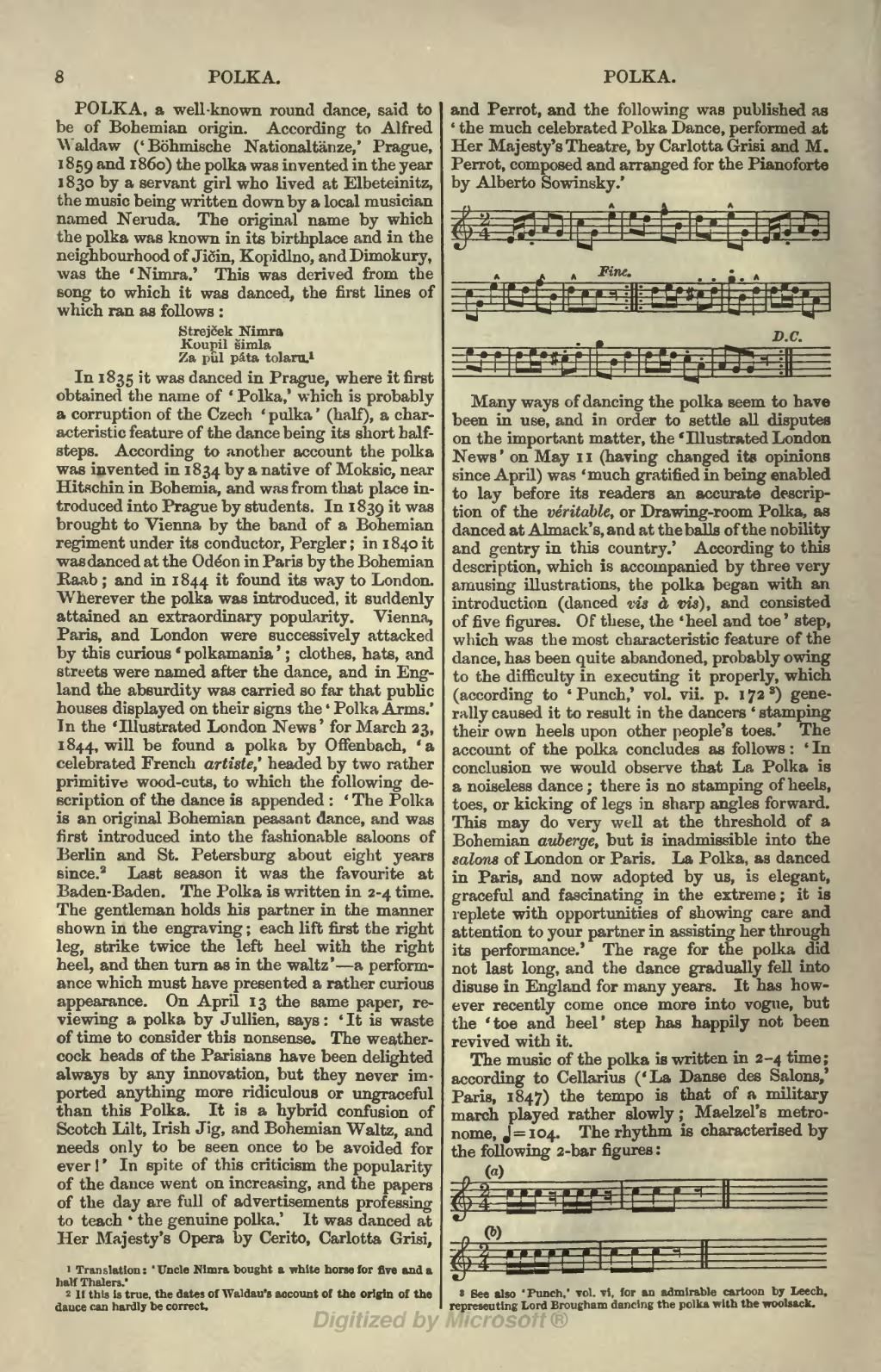POLKA, a well-known round dance, said to be of Bohemian origin. According to Alfred Waldaw ('Böhmische Nationaltänze,' Prague, 1859 and 1860) the polka was invented in the year 1830 by a servant girl who lived at Elbeteinitz, the music being written down by a local musician named Neruda. The original name by which the polka was known in its birthplace and in the neighbourhood of Jičin, Kopidlno, and Dimokury, was the 'Nimra.' This was derived from the song to which it was danced, the first lines of which ran as follows:
Strejček Nimra
Koupil šimla
Za pûl páta tolaru.[1]
In 1835 it was danced in Prague, where it first obtained the name of 'Polka,' which is probably a corruption of the Czech 'pulka' (half), a characteristic feature of the dance being its short half-steps. According to another account the polka was invented in 1834 by a native of Moksic, near Hitschin in Bohemia, and was from that place introduced into Prague by students. In 1839 it was brought to Vienna by the band of a Bohemian regiment under its conductor, Pergler; in 1840 it was danced at the Odéon in Paris by the Bohemian Raab; and in 1844 it found its way to London. Wherever the polka was introduced, it suddenly attained an extraordinary popularity. Vienna, Paris, and London were successively attacked by this curious 'polkamania'; clothes, hats, and streets were named after the dance, and in England the absurdity was carried so far that public houses displayed on their signs the 'Polka Arms.' In the 'Illustrated London News' for March 23, 1844, will be found a polka by Offenbach, 'a celebrated French artiste,' headed by two rather primitive wood-cuts, to which the following description of the dance is appended: 'The Polka is an original Bohemian peasant dance, and was first introduced into the fashionable saloons of Berlin and St. Petersburg about eight years since.[2] Last season it was the favourite at Baden-Baden. The Polka is written in 2-4 time. The gentleman holds his partner in the manner shown in the engraving; each lift first the right leg, strike twice the left heel with the right heel, and then turn as in the waltz'—a performance which must have presented a rather curious appearance. On April 13 the same paper, reviewing a polka by Jullien, says: 'It is waste of time to consider this nonsense. The weathercock heads of the Parisians have been delighted always by any innovation, but they never imported anything more ridiculous or ungraceful than this Polka. It is a hybrid confusion of Scotch Lilt, Irish Jig, and Bohemian Waltz, and needs only to be seen once to be avoided for ever!' In spite of this criticism the popularity of the dance went on increasing, and the papers of the day are full of advertisements professing to teach 'the genuine polka.' It was danced at Her Majesty's Opera by Cerito, Carlotta Grisi, and Perrot, and the following was published as 'the much celebrated Polka Dance, performed at Her Majesty's Theatre, by Carlotta Grisi and M. Perrot, composed and arranged for the Pianoforte by Alberto Sowinsky.'

Many ways of dancing the polka seem to have been in use, and in order to settle all disputes on the important matter, the 'Illustrated London News' on May 11 (having changed its opinions since April) was 'much gratified in being enabled to lay before its readers an accurate description of the véritable, or Drawing-room Polka, as danced at Almack's, and at the balls of the nobility and gentry in this country.' According to this description, which is accompanied by three very amusing illustrations, the polka began with an introduction (danced vis à vis), and consisted of five figures. Of these, the 'heel and toe' step, which was the most characteristic feature of the dance, has been quite abandoned, probably owing to the difficulty in executing it properly, which (according to 'Punch,' vol. vii. p. 172[3]) generally caused it to result in the dancers 'stamping their own heels upon other people's toes.' The account of the polka concludes as follows: 'In conclusion we would observe that La Polka is a noiseless dance; there is no stamping of heels, toes, or kicking of legs in sharp angles forward. This may do very well at the threshold of a Bohemian auberge, but is inadmissible into the salons of London or Paris. La Polka, as danced in Paris, and now adopted by us, is elegant, graceful and fascinating in the extreme; it is replete with opportunities of showing care and attention to your partner in assisting her through its performance.' The rage for the polka did not last long, and the dance gradually fell into disuse in England for many years. It has however recently come once more into vogue, but the 'toe and heel' step has happily not been revived with it.
The music of the polka is written in 2-4 tune; according to Cellarius ('La Danse des Salons,' Paris, 1847) the tempo is that of a military march played rather slowly; Maelzel's metronome, ![]() = 104. The rhythm is characterised by the following 2-bar figures:
= 104. The rhythm is characterised by the following 2-bar figures:
![{ \time 2/4 \relative c'' { c16^"(a)" c c r c c c r | c8[ c c] r \bar "||" } }](http://upload.wikimedia.org/score/b/6/b6y5k0kazs5bqlzx2o81hqelfxxlvv2/b6y5k0ka.png)
![{ \time 2/4 \relative c'' { c16^"(b)" c c c c8 c | c[ c c] r \bar "||" } }](http://upload.wikimedia.org/score/i/v/ivibu0eqtsebram41fp6grahi3zxnc8/ivibu0eq.png)
- ↑ Translation: 'Uncle Nimra bought a white horse for five and a half Thalers.'
- ↑ If this is true, the dates of Waldau's account of the origin of the dance can hardly be correct.
- ↑ See also 'Punch,' vol. vi, for an admirable cartoon by Leech, representing Lord Brougham dancing the polka with the woolsack.

